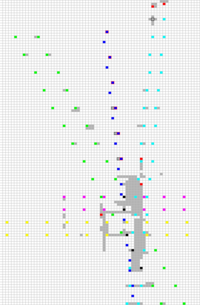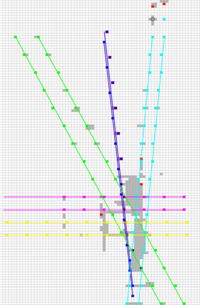The Wiki for Tale 4 is in read-only mode and is available for archival and reference purposes only. Please visit the current Tale 11 Wiki in the meantime.
If you have any issues with this Wiki, please post in #wiki-editing on Discord or contact Brad in-game.
Limestone blocks
Supplies Needed
- Glass Rods (200-400 is a good starting number)
- Lead Mallet
- Cooked Food (Focus/Perception, Endurance)
- Linen and Copper Wire (for construction site)
Find a Location
- Find an area with all sand.
- Avoid hills and mountains.
- Sink your boreholes (if you can see the grid, you want these to be in the center of each coord) Start with a 20x20.
Finding Blocks
- Eat perception/focus food (stack herbs as well, if possible)
Blocks List
- List of blocks to find a pattern.
| Location | Location | Location | Location | Location |
|---|---|---|---|---|
| -190 -6152 | -179 -6152 | -176 -6154 | -184 -6154 | -189 -6157 |
| -178 -6157 | -175 -6160 | -183 -6160 | -189 -6162 | -178 -6162 |
| -176 -6166 | -184 -6166 | -179 -6167 | -189 -6167 |
Ralomein's Block Chart
Updated Theory: Limestone blocks are found in straight lines running vertical, horizontal, or diagonal, and are always found in identical pairs separated by a few coordinates vertically or horizontally. Within the line, blocks are commonly found every 7 horizontal or vertical coordinates, but not always - I have a line with blocks every 10 vertical coordinates with a -1 horizontal shift. Blocks are quite dense so it can be difficult at first to determine which blocks are part of the same line. Where two lines of blocks intersect, they can share a block.
Using those rules, essentially turns block finding into a puzzle - kudos to Teppy. I highly recommend you keep track of locations you have bored and hit rock, as that data can be used to eliminate other locations that will not have a block for the line you are working on -- which in the end saves you on glass rods. The chart below is simply an OpenOffice spreadsheet with column width changed to make square cells, and I change the background color of the cell to indicate a hit or miss.
I have found something I cannot explain, which may be part of the overall puzzle, or could potentially be a mathematical bug. In the line with a +10 vertical and -1 horizontal shift, the identical pair to it is now shifted 1 horizontal coordinate from it's expected location, starting about halfway through the line. This could be due to rounding, which over many coordinates could cause a shift slightly toward the coordinate border and eventually crossing it. Look at the 2 blue lines (hard to tell it's actually two - the duplicate is 4 coordinates north. The Blue boxes with a red border indicate where the shift occurs.
On the chart - color indicates a block found, grey are spots I bored but found no block. Black are blocks shared by more than 1 line, and red are blocks that I have not yet found the line for.
A better display of the unexplained shift in the blue line.

